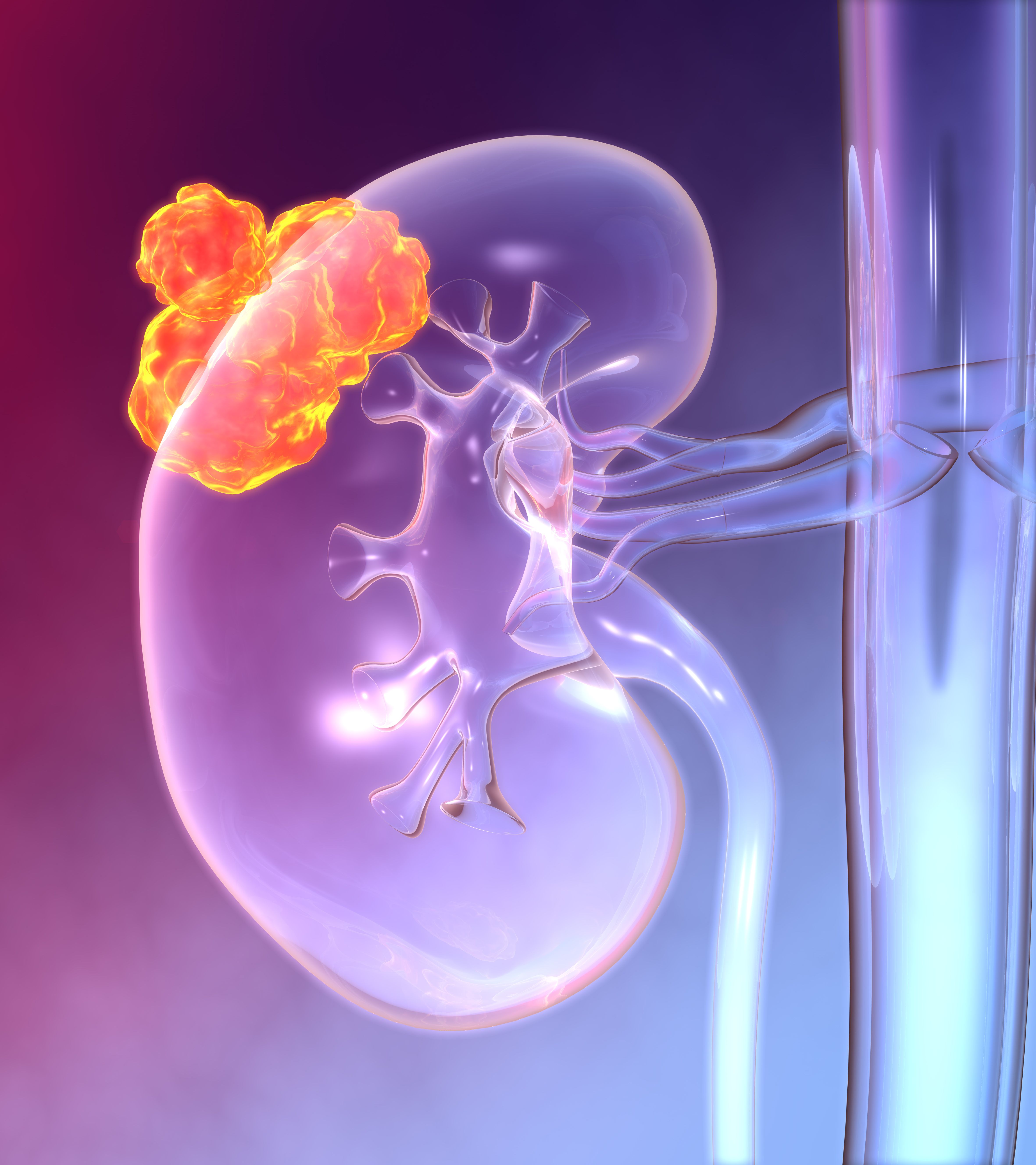KIM-1: A Promising Biomarker for MRD, Recurrence, and Atezolizumab Benefit in RCC
A retrospective analysis of the phase 3 IMmotion010 trial suggests that KIM-1 levels might hold promise as a biomarker in renal cell carcinoma.
Kidney cancer, colorful medically 3D illustration: © Axel Kock - stock.adobe.com

A retrospective analysis of the phase 3 IMmotion010 trial (NCT03024996) presented at ASCO 2024 suggests that circulating kidney injury molecule-1 (KIM-1) levels might hold promise as a biomarker in renal cell carcinoma (RCC).
While the previously reported topline results showed no significant difference in disease-free survival (DFS) between adjuvant atezolizumab (Tecentriq) and placebo in high-risk patients with RCC with a median DFS of 57.2 months vs 49.5 months (HR 0.93; 95% CI, 0.75-1.15, P =.50), KIM-1 levels potentially correlated with minimal residual disease (MRD), disease recurrence, and response to atezolizumab.2 This warrants further investigation, as a non-invasive tool for identifying minimal residual disease (MRD) and guiding adjuvant atezolizumab therapy in high-risk RCC could be clinically valuable.
In her presentation at the ASCO meeting, lead study author, Laurence Albiges, MD, PhD, chair of the medical oncology department at Gustave Roussy Institute in Villejuif, France, explained that the purpose of the retrospective analysis was to use the IMmotion010 data to examine “circulating protein biomarkers to identify high-risk patients with MRD who may show differential benefit from atezolizumab treatment.”1
Albiges said the biomarker analysis revealed that “KIM-1, a type 1 membrane glycoprotein, was the most significantly enriched circulating protein in recurrence vs baseline serum samples in IMmotion010.”
Albiges et all next looked at baseline characteristics for patients with KIM-1–high status (n = 300) and KIM-1–low status (n = 452). The characteristics, which were well balanced between the 2 groups, included median age (median 64 years in KIM-1–high vs 58 years in KIM-1–low), gender (77% male vs 69% male, respectively), PD-L1 status (positive: 63% vs 59%), and sarcomatoid component (16% vs 11%). Most patients in each group had T2/T3a pathologic disease stage (57% vs 69%) and stage III disease stage (83% vs 86%).
Among patients with KIM-1–high status at baseline, atezolizumab improved DFS vs placebo (median DFS, NE vs 21.16 months; HR, 0.72; 95% CI, 0.52-0.99), while atezolizumab did not improve DFS in patients with low KIM-1 at baseline (median DFS, 57.23 months vs NE; HR, 1.12; 95% CI, 0.88-1.63).
“In the KIM-1–high subgroup, patients were less likely to experience an on-treatment increase in KIM-1 levels with atezolizumab vs placebo,” said Albiges. Among patients with KIM-1–high status at baseline, 9% had an on-treatment KIM-1 increase vs 15% in the placebo group. In the KIM-1 low group, the rates were a 16% increase with atezolizumab vs 14% increase with placebo.
“On-treatment increase in KIM-1 was associated with worse DFS in both the KIM-1–high and KIM-1–low subgroups,” noted Albiges, and “Serum KIM-1 levels increased at the time of disease recurrence vs baseline.”
IMmotion010 Background
The double-blind phase 3 IMmotion010 trial (NCT03024996) enrolled 778 patients with RCC at 215 clinical sites across 28 countries between January 3, 2017, and February 15, 2019. Patients had disease with a clear cell or sarcomatoid component and increased risk of recurrence following nephrectomy with or without metastasectomy.
The median patient age was 60 years, 73% of patients were male, and about 80% of patients were White. Overall, 79% of patients had an ECOG performance status (PS) of 0 and 21% had an ECOG PS of 1. Sixty-four percent of patients had stage T2 or T3a disease, and 22% of patients had stage T3b–c or T4 or N+ disease. Forty percent of patients were negative for PD-L1 immune cell expression on their tumors and 60% were positive.
Patients were randomized in a 1:1 ratio to adjuvant atezolizumab (390 patients) placebo (388 patients). Atezolizumab (1200 mg) or matching placebo were both administered intravenously once every 3 weeks for 16 cycles or 1 year. Investigator-assessed DFS in the intention-to-treat (ITT) population was the primary end point.
Next Steps
Looking ahead, Albiges said, “Additional validation studies are warranted to confirm the utility of circulating KIM-1 in adjuvant RCC as a noninvasive biomarker for identification of MRD, predicting outcomes to checkpoint inhibitor treatment, and longitudinal monitoring for disease recurrence.”
References
1. Albiges L, Bex A, Suárez C, et al. Circulating kidney injury molecule-1 (KIM-1) biomarker analysis in IMmotion010: A randomized phase 3 study of adjuvant (adj) atezolizumab (atezo) vs placebo (pbo) in patients (pts) with renal cell carcinoma (RCC) at increased risk of recurrence after resection.J Clin Oncol 42, 2024 (suppl 16; abstr 4506). doi: 10.1200/JCO.2024.42.16_suppl.4506
2. Bex A, Uzzo R, Karam JA, et al. IMmotion010: Efficacy and safety from the phase III study of atezolizumab (atezo) vs placebo (pbo) as adjuvant therapy in patients with renal cell carcinoma (RCC) at increased risk of recurrence after resection. Ann Oncol. 2022;33(suppl 7):S808-S869. doi:10.1016/annonc/annonc1089
Enhancing Precision in Immunotherapy: CD8 PET-Avidity in RCC
March 1st 2024In this episode of Emerging Experts, Peter Zang, MD, highlights research on baseline CD8 lymph node avidity with 89-Zr-crefmirlimab for the treatment of patients with metastatic renal cell carcinoma and response to immunotherapy.
Listen
Beyond the First-Line: Economides on Advancing Therapies in RCC
February 1st 2024In our 4th episode of Emerging Experts, Minas P. Economides, MD, unveils the challenges and opportunities for renal cell carcinoma treatment, focusing on the lack of therapies available in the second-line setting.
Listen
Peers Discuss Management of IO/TKI Toxicities and Dosing Strategies in Frontline RCC
March 11th 2025During a Case-Based Roundtable® event, Elizabeth M. Wulff-Burchfield, MD, and other participants discussed their experiences with the frontline combination regimens for advanced renal cell carcinoma.
Read More






